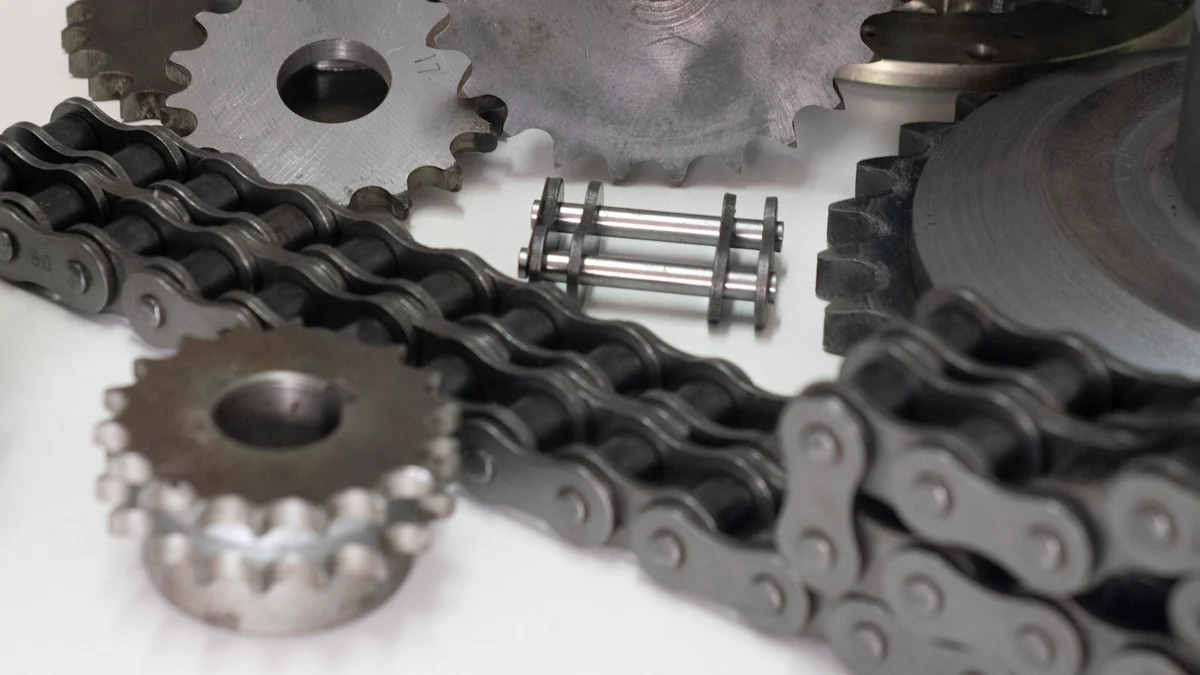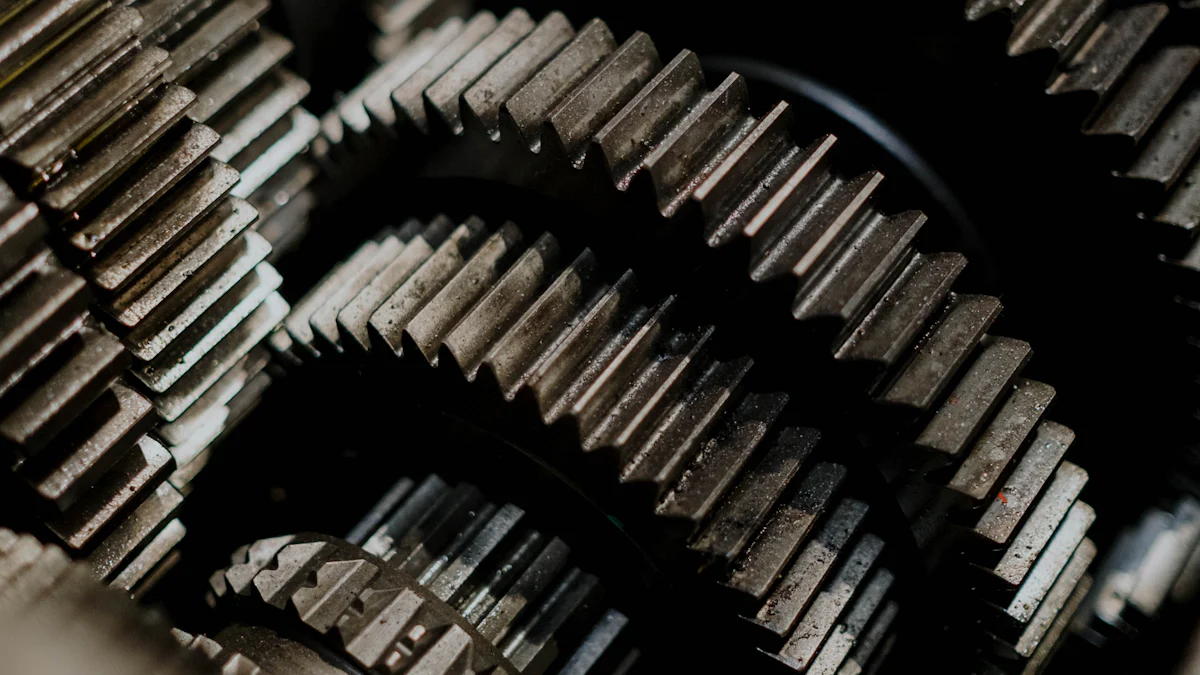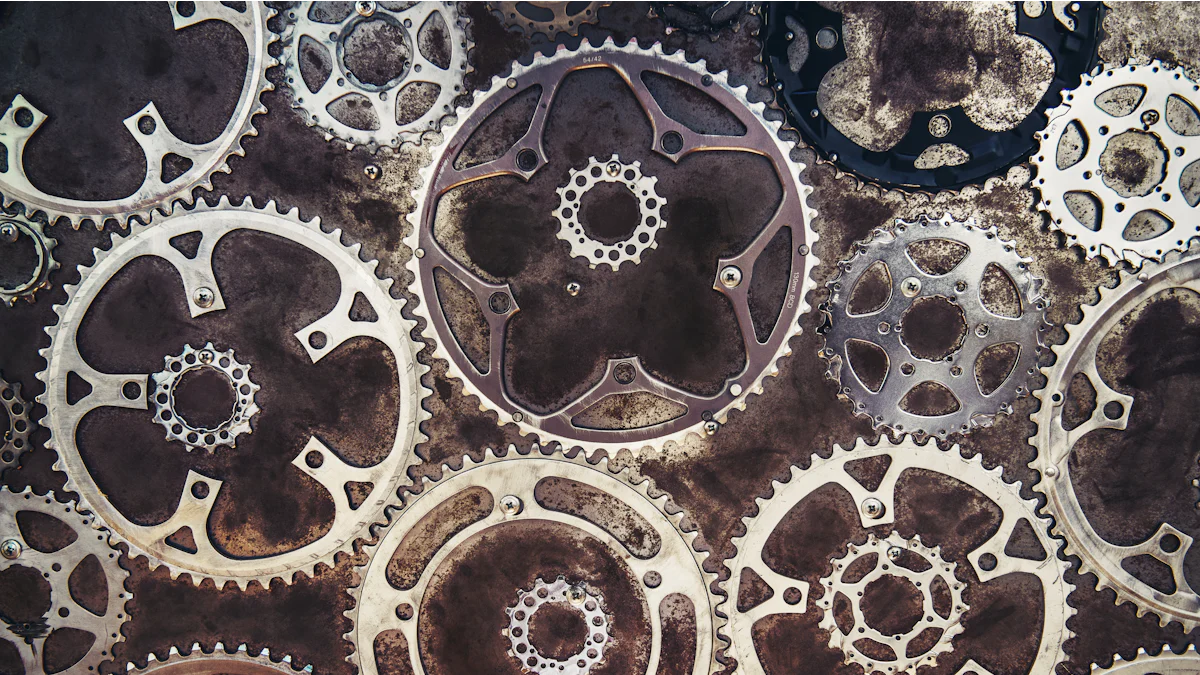
Powder metal gears play a vital role in modern industries by offering innovative solutions to critical challenges. Their near-net-shape design reduces material waste and environmental impact while maintaining exceptional performance. Industries like automotive benefit from significant cost savings and lower CO2 emissions. These gears, made through powder metallurgy, ensure uniform production and self-lubrication, enhancing efficiency and sustainability.
| Aspect | Contribution to Efficiency and Sustainability |
|---|---|
| Manufacturing Process | Uses powder metallurgy, reducing material waste and enabling uniform production. |
| Material Properties | Long-wearing, porous, and self-lubricating, enhancing performance and reducing maintenance. |
| Applications | Suitable for various industries, including automotive, enhancing versatility. |
Benefits of Powder Metal Gears

Noise Reduction and Smooth Operation
I’ve observed that noise reduction is a critical factor in gear performance, especially in industries like automotive. Powder metal gears excel in this area due to their unique material properties. The damping characteristics of these gears, influenced by their density, significantly reduce noise emissions. This makes them ideal for applications requiring quieter operations.
Additionally, the porous structure of powder metal gears, with up to 10% porosity, enhances sound dampening. This porosity not only minimizes noise but also contributes to smoother gear operation. These features make powder metal gears a preferred choice for industries prioritizing efficiency and comfort.
Lightweight and High Strength
Powder metal gears combine lightweight properties with exceptional strength. Their controlled porosity reduces mass while maintaining structural integrity. Manufacturers often use lower-density materials like titanium or aluminum to achieve lightweight components without compromising durability.
| Property | Description |
|---|---|
| Controlled Porosity | Reduces mass and density, providing inherent weight reduction. |
| Thinner Sections | High specific strength allows for thinner designs while maintaining strength. |
| Strength-to-Weight Ratio | Fine dispersed carbides provide good specific strength for their weight. |
These gears also allow for part consolidation, where multiple mechanical elements are combined into a single piece. This reduces weight and simplifies assembly. Their strength-to-weight ratio ensures they perform reliably under demanding conditions.
Environmental Advantages and Sustainability
Powder metal gears offer significant environmental benefits. Their lightweight design reduces inertia losses by 6-7%, enhancing energy efficiency and lowering operational costs. The manufacturing process minimizes material waste, contributing to sustainability.
The porosity of these gears also plays a role in reducing noise emissions, which aligns with eco-friendly practices. By using fewer raw materials and optimizing energy consumption, powder metal gears support industries aiming to reduce their carbon footprint. These advantages make them a sustainable choice for modern manufacturing.
Technical Aspects of Powder Metal Gears
Manufacturing Process and Self-Lubrication
The manufacturing process of powder metal gears involves several precise steps to ensure quality and performance. First, I mix the metal powders to achieve the desired composition. Next, I compact the powders into the required shape using high-pressure tooling. Finally, I heat the compacted shape under controlled conditions, a process known as sintering. This step bonds the particles together, creating a solid structure.
The porosity of sintered parts plays a crucial role in self-lubrication. These pores retain lubricants like oil or graphite, which continuously lubricate the gear’s contact surfaces. This reduces wear and extends the gear’s lifespan. Self-lubrication also minimizes maintenance requirements, making these gears highly efficient for various applications.
Porosity, Durability, and Stress Reduction
Porosity impacts both the durability and stress-handling capabilities of powder metal gears. While higher porosity can reduce fatigue strength in high-stress areas, I’ve found that optimizing tooth density through techniques like roll densification significantly improves performance. For instance, densified teeth can enhance bending fatigue strength by 32% and increase contact fatigue strength by 3.5 times. Eliminating pores in critical areas ensures these gears withstand demanding conditions without compromising durability.
Performance and Accuracy Compared to Conventional Gears
Powder metal gears match the performance and accuracy of conventional machined gears in many aspects. They offer comparable fatigue properties and dimensional precision. For example, rolled, case-hardened powder metal gears achieve 96% of the contact fatigue strength of case-hardened wrought steel gears. Additionally, their manufacturing process requires less energy and produces minimal waste, making them a cost-effective and sustainable alternative.
Cost-Effectiveness of Powder Metal Gears
Production Costs and Scalability
Producing powder metal gears offers significant cost advantages over traditional manufacturing methods. I’ve observed that high material utilization plays a key role in reducing costs. The process minimizes waste and eliminates the need for extensive secondary operations, thanks to its ability to achieve tight tolerances. This efficiency translates into lower overall production expenses.
Cost-effectiveness is the predominant reason OEMs request powder metallurgy services. PM wins the cost competition vs. machining thanks to: elimination of process steps and more efficient material use.
Scalability is another major benefit. Powder metallurgy adapts seamlessly to both small and large production volumes. Manufacturers can maintain consistent quality across runs without major adjustments.
| Benefit | Description |
|---|---|
| Consistent Reproducibility | Ensures uniform quality across production runs. |
| Wide Range of Production Volumes | Can adapt to both small and large production needs without major changes. |
| Cost-Effectiveness | High material utilization leads to lower manufacturing costs. |
| Tight Tolerances | Reduces the need for additional machining, saving time and costs. |
Profitability for High-Volume Manufacturing
Powder metal gears excel in high-volume manufacturing. Their near-net-shape production minimizes secondary machining, reducing labor and material costs. I’ve found that this approach not only saves time but also ensures precise dimensions, which improves performance and reduces waste.
| Benefit | Description |
|---|---|
| Cost-effectiveness | High material utilization leads to lower costs in production. |
| Reduced secondary operations | Near-net-shape production minimizes the need for additional machining processes. |
| Tight tolerances and accuracy | Ability to produce gears with precise dimensions, reducing waste and improving performance. |
| Environmental benefits | Low energy usage and minimal scrap make the process more sustainable compared to traditional methods. |
This combination of cost savings and efficiency makes powder metal gears a profitable choice for industries requiring large-scale production.
Material and Energy Savings
The production of powder metal gears is inherently efficient. The process achieves near-net-shape or net shape, which reduces the need for secondary operations like machining. High material utilization further contributes to cost savings and shorter production times.
- Powder metallurgy generates little to no waste, making it an environmentally friendly option.
- The process consumes less energy compared to traditional methods, lowering operational costs.
- Manufacturers benefit from reduced raw material usage, which aligns with sustainability goals.
These material and energy savings make powder metal gears an attractive option for industries focused on cost efficiency and environmental responsibility.
Practical Applications and Limitations

Industries Utilizing Powder Metal Gears
Powder metal gears have become indispensable across a wide range of industries due to their versatility and performance. In the automotive sector, I’ve seen these gears used extensively in engine components like sprockets, pulleys, and turbocharger systems. They also play a critical role in transmissions, electric powertrains, and steering systems, where their high strength and wear resistance ensure reliable power transfer.
Beyond automotive, these gears find applications in agriculture, marine, and material handling industries. For example, they are used in farming equipment, boat engines, and conveyor systems. Other sectors, such as medical devices, outdoor power equipment, and power tools, also benefit from the durability and precision of powder metal gears.
- Common industries include:
- Agriculture
- Fluid handling
- Lawn and garden
- Recreational equipment
- Appliances
Design and Size Constraints
The design and size of powder metal gears face certain limitations due to the manufacturing process. The compaction press size restricts the maximum dimensions of these gears. For instance, gears with larger face widths or steep helix angles, such as worm and helical gears, may not be feasible.
Porosity, while beneficial for self-lubrication, can reduce impact resistance and contact fatigue strength. I’ve observed that techniques like double pressing or roll densification can mitigate these issues by increasing density. However, density variations during compaction can lead to distortion during heat treatment, especially in non-spur gears. These constraints require careful consideration during the design phase.
Suitability for Specific Applications
Powder metal gears excel in applications requiring precision, durability, and cost efficiency. They are ideal for engine parts like oil pump gears and gear shift components, where their wear resistance ensures long-term reliability. In the marine industry, these gears perform well in boat engines and other components exposed to harsh environments.
| Industry | Application Examples |
|---|---|
| Agriculture | Farming equipment |
| Power transmission | Machinery gear systems |
| Marine | Boat engines and components |
| Lawn and Garden | Lawn mowers and garden tools |
| Medical | Surgical and diagnostic devices |
Their suitability for diverse applications makes powder metal gears a preferred choice for manufacturers seeking cost-effective and high-performance solutions.
Powder metal gears deliver unmatched benefits in cost-effectiveness, material efficiency, and environmental sustainability. Their lightweight design enhances performance while reducing noise and energy consumption. With growing demand for eco-friendly solutions and advancements in automation, these gears promise a bright future across industries like automotive, healthcare, and agriculture, driving innovation and sustainability forward.
Benefit Description Cost-effectiveness High material utilization leads to lower manufacturing costs compared to traditional methods. Material efficiency Minimal waste generated during production, contributing to sustainability. Reduced environmental impact Low energy usage and minimal scrap make the process greener than standard machining or casting. Tight tolerances Allows for precision manufacturing, reducing the need for additional operations. Consistent reproducibility Ensures uniformity in production, enhancing reliability. Versatile production volume Capable of accommodating a wide range of production needs, from low to high volumes.
FAQ
What are the main advantages of powder metal gears?
Powder metal gears offer cost savings, lightweight design, and self-lubrication. Their manufacturing process minimizes waste and energy consumption, making them efficient and environmentally friendly.
Can powder metal gears replace traditional machined gears?
Yes, they can replace traditional gears in many applications. Powder metal gears provide comparable strength, precision, and durability while being more cost-effective and sustainable.
Are there limitations to using powder metal gears?
Yes, size and design constraints exist due to compaction press limits. Porosity may reduce impact resistance, but densification techniques can improve performance in critical areas.
